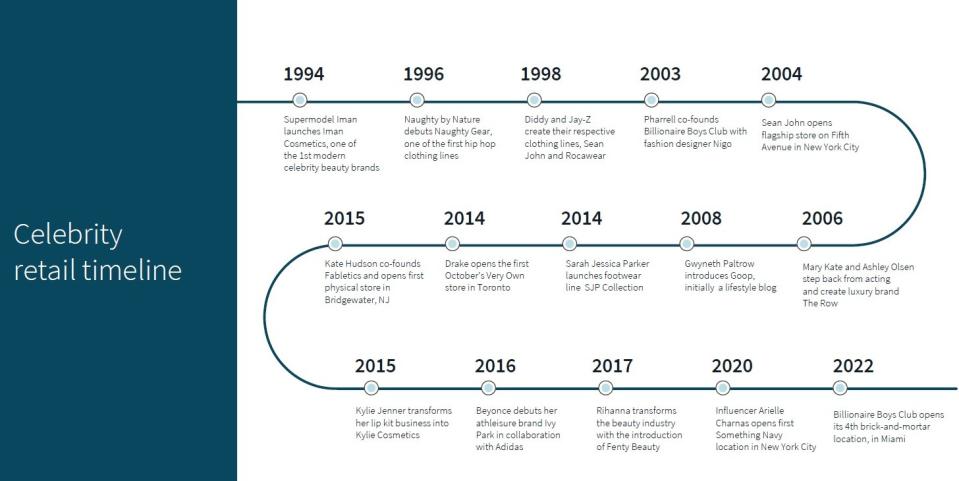How Growth in Celebrity Brands Is Affecting the Retail Industry

When Khloé Kardashian and Emma Grede launched their Good American brand in 2016, one of the first things they did a year later was plant their first pop-up store inside VFiles’ outpost in New York City.
Seven years later, the famous duo branched out with their first permanent Good American store, which opened in June at the Westfield Century City mall in Los Angeles.
More from WWD
Good American Launches Its Varsity Collection in Time for the Academic Year
Guess Inc. Sees Tough Sales in the Americas but Europe and Asia Provide a Silver Lining
And more stores are on the way. “We’re scaling quickly. There will be a lot more stores opening next year,” Grede, the company’s chief executive officer, said during the opening of the 3,000-square-foot space. Two more stores are scheduled to open later this year at Fashion Island in Newport Beach, California, and The Forum Shops at Caesars Palace in Las Vegas.
Good American followed the path that many celebrity brands have taken. A recent study by commercial real estate and investment management company JLL shows that celebrity brands tend to place their first pop-up store in New York but opt for Los Angeles when they establish their first brick-and-mortar outpost. In the last decade, the report said, celebrity-backed retail brands have opened more than 300,000 square feet of retail space.
“When it comes to where pop-ups decide to open, New York has been a breeding ground for this retail concept,” said Ebere Anokute, the report’s author and a research manager in retail for JLL, also known as Jones Lang LaSalle.
The researcher noted that New York has more foot traffic than most urban areas, which is a plus for attracting customers, and is populated with a number of prime retail streets. “There are a lot of developers and landlords in New York that are really devoted to testing out new retail concepts, whether you look at the shops at Hudson Yards and their entire Floor of Discovery or you look at what has been done on Bleecker Street. It’s a breeding ground for digital-native concepts to test out opening physical stores.”
SoHo is probably one of the most popular areas for pop-ups, he noted, and Brooklyn’s Williamsburg is emerging as a new hot pop-up store spot because of lower retail rents and younger customers living in the hip neighborhood.
Pop-up stores are cheaper to set up than permanent units, help brand owners test consumer response to their products and provide experiential marketing opportunities.
When it is time to leap into permanent retail, celebrity brands often opt for Los Angeles, where neighborhood outdoor and indoor malls attract shoppers from various locations and rents are cheaper than in New York. “The focus on L.A. has a lot to do with a better deal in rents, and the preponderance of people in the entertainment industry living there who can promote their brand,” Anokute said.
Skims, cofounded by Kim Kardashian, is opening its first brick-and-mortar location next year on Sunset Boulevard in West Hollywood. Other celebrity brands that opened their first stores in Los Angeles include Gwyneth Paltrow’s Goop, Tyler, the Creator’s Golf Wang, and Mary-Kate and Ashley Olsen’s The Row.

The rise of celebrity brand stores is becoming the silver lining for malls and retail streets that have been struggling to fill vacant storefronts. Fabletics, the athleisure brand cofounded 10 years ago by actor Kate Hudson, now has 13 of its 95 stores in Los Angeles-area malls.
These kinds of retail stores are coveted by shopping malls. Late last year, mall owner Simon Property Group teamed with Leap, a company that brings online brands into the brick-and-mortar retail world, to help populate their nearly 100 malls. Simon and Leap began by bringing four stores — True Classic Tees, ThirdLove, Sugarfina and Goodlife — to the Del Amo Mall in Los Angeles and Town Center in Boca Raton, Florida.
In the JLL report, researchers found that when it comes to starting a brand, most celebrities gravitate toward the beauty category, which can turn a profit quickly. Kylie Jenner had a lucrative return on investment when she started Kylie Cosmetics in 2015. Five years later, she reached a deal to sell a 51 percent stake in her company for $1.2 billion to legacy brand Coty. And Rihanna launched her Fenty Beauty brand, with a 40-shade foundation range, in 2017. LVMH Moët Hennessy Louis Vuitton backs the brand, which Forbes now values at $1.4 billion.
Since 2017, 53 percent of celebrity brands have been in beauty while 41 percent have been in apparel. “I think a lot of these brands end up in beauty because there is a lower barrier to entry,” Anokute of JLL said. “When it comes to apparel and other categories, you have to focus on having a really wide size range, returns and people coming in to feel the clothes.”
Opening stores is also becoming a cheaper way to attract customers. Celebrity brands, which emerged in 2017 and took off during the pandemic in 2020, are discovering that retail might be a more economical way of acquiring customers. The JLL report noted that the average cost to acquire an online customer in 2023 was about $70 compared with $58 in 2021 and $25 in 2018.
“Right now, we’re seeing that celebrity brands are very bullish about opening physical stores,” Anokute said. “They’ve seen that malls are a great place to market to consumers. I also see a bit of symbiosis going on between mall operators and these digital brands to resolve vacancies.”
Best of WWD


